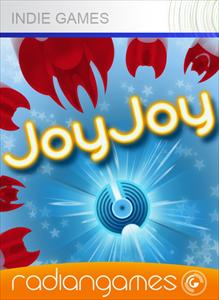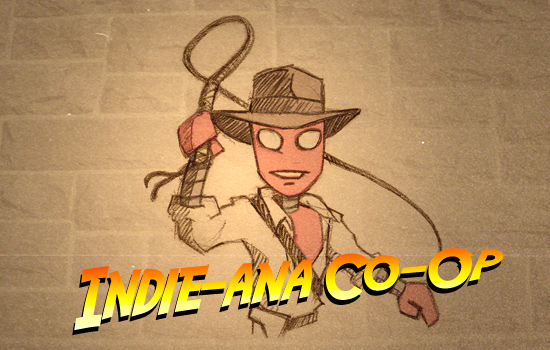JoyJoy
Developer: radiangames
Genre: Twin-Stick Arena Shooter
Available On: XBLIG
Co-Op Mode: Local (2 players)
Price: 80 MS Points ($1)
Demo w/ Co-Op Available: Yes
Doing a search around the XBLIG section on your Xbox will usually yield a few games that can be broadly categorized as “twin-stick shooters” (though, primarily, this is a simplification of just the gameplay mechanics). We’ve even covered a few of these shooter-types in previous Indie-Ana Co-Ops, but radiangames’ JoyJoy is the first I’ve played that has sparked the simple, yet profound, reaction of joy in playing the game.
The game proceeds through a series of 24 waves with various enemies of different shapes and sizes (though they generally fall into either the “swarmers” or “shooters” categories) out to ruin your day. You’re given three lives, which are replenished in between waves, and an arsenal of six weapons to aid you in your survival efforts, which you build up over the course of the first few waves. Enemies will drop weapon upgrades, extra lives, and other ship upgrades, like moving or shooting faster, as the waves proceed. Finally, gather enough of the stars that enemies leave behind when killed and you’ll unleash either an explosion of bullets, or create a vortex that pulls all the foes into one convenient spot. The phrase “fish-in-a-barrel” certainly comes to mind.
To vary things up a bit, every fourth wave brings either a “swarm” or a boss stage. As the name suggests, the “swarm” waves entail fending off an ever increasing number of enemies that are on a purely “seek-n-crash into” mission. The bosses are tougher versions of the shooter enemies encountered thus far and make things a little more “bullet hell-ish.” These game changers not only help to break up the repetition, but they also affect the game’s appearance. One of the most striking elements of JoyJoy is its graphic style. The game starts as a simple “blue v red” motif, but then flip-flops at the first swarm stage and changes altogether after the first boss. While this kind of a change is a rather simple one, it adds to the overall experience of the game. Not only has the player cleared a milestone in the game, which typically elicits some sort of emotional response, but also the game itself responds to this accomplishment by changing up how it looks.

To quote a personal hero of mine, Professor Frank: "The colors, children, the colors!"
Co-op in JoyJoy is a local 2-player only affair, but it does have the benefit of supporting drop-in drop-out so your friend can hop in when help is needed most and will have access to all the same weapons (and their upgrades) as the first player. Much of the co-op experience is what one would expect from a twin-stick shooter: both players work as a team to do their best to shoot down the enemies. There’s a little bit of an added benefit to having a second player help out, though, in that players can charge their weapons’ shots in order to unleash a more powerful attack. With a second player there to help watch your back, these charge attacks become easier to pull off and thus gives you a big advantage in getting to the later waves.
When you stop and look at it, JoyJoy is one of those games that is quite aptly named. Its gameplay and graphics are rather simplistic, when compared to other games and shooters out there, yet they are also so well designed and implemented that they elicit that feeling that all games should: joy.
Wrap-Up
JoyJoy is For: Twin-stick shooter fans, be they hardcore or casual, JoyJoy has a difficulty level for you with the ability to add-in different modifications to customize the overall experience
The Co-Op Experience: Each player controls a ship with access to the same set of weapons, which can be charged to unleash more devastation; players have three lives for each wave and these lives are replenished between each wave
